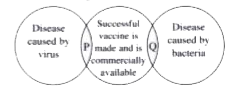The second meiotic division of ………..P …….. is unequal and results in the formation of ………. Q …….. .
Select the appropriate option for P and Q.
P-secondary spermatocytes, Q-spermatids
P-primary oocyte, Q-ovum
P-secondary oocyte, Q-polar body
P-primary spermatocytes, Q-spermatids
The correct Answer is:C
To solve the question regarding the second meiotic division of P and the formation of Q, we need to analyze the options given and understand the process of meiosis, particularly in the context of oogenesis (the formation of female gametes).
1. Understanding Meiosis: Meiosis consists of two divisions: the first meiotic division (Meiosis I) and the second meiotic division (Meiosis II). In females, meiosis occurs during oogenesis, which leads to the formation of ova (egg cells).
2. Identifying P: The question states that the second meiotic division of P is unequal. In oogenesis, the second meiotic division occurs in the secondary oocyte. This division is unequal because it produces one large ovum and one smaller polar body.
3. Identifying Q: The result of the second meiotic division of the secondary oocyte (P) is the formation of the ovum (Q). The polar body produced during this division is not a functional gamete and is much smaller than the ovum.
4. Evaluating Options:
- Option 1: Secondary spermatocyte and spermatids (not applicable as this refers to male gamete formation).
- Option 2: Primary oocyte and ovum (not applicable as the primary oocyte undergoes the first meiotic division).
- Option 3: Secondary oocyte and polar body (this is partially correct but does not specify the ovum).
- Option 4: Primary spermatocytes and spermatids (not applicable as this refers to male gamete formation).
5. Conclusion: The correct answer is that P is the "secondary oocyte" and Q is the "ovum". The second meiotic division of the secondary oocyte is unequal and results in the formation of the ovum and a polar body.
Final Answer:
P = Secondary oocyte
Q = Ovum
- Option 1: Secondary spermatocyte and spermatids (not applicable as this refers to male gamete formation).
- Option 2: Primary oocyte and ovum (not applicable as the primary oocyte undergoes the first meiotic division).
- Option 3: Secondary oocyte and polar body (this is partially correct but does not specify the ovum).
- Option 4: Primary spermatocytes and spermatids (not applicable as this refers to male gamete formation).
P = Secondary oocyte
Q = Ovum
Topper's Solved these Questions
Similar Questions
Knowledge Check
- Question 1 - Select One
Select the most appropriate option for blank No. (###Q4###).
Amore largerBlargerClargeDlargest - Question 2 - Select One
Select the most appropriate option for blank No. (###Q3###).
AroadBrouteCmeansDpath - Question 3 - Select One
On an average, female cockroach produce ………P…………..oothecae, each containing ……….Q……..eggs. Select the appropriate option for P and Q.
AP−9−10,Q−16−18BP−9−10,Q−14−16CP−14−16,Q−9−10DP−14−16,Q−10−12
Meiotic division during oogenesis is termed as an unequal division because:
View SolutionRefer to the given Venn diagram and select the correct option regarding P and Q.
 View Solution
View SolutionHow many meiotic divisions are required during the formation of 500 zzygotes, if in males one meiotic division result in formation of four male gametes and in females one meiotic divison results in formation of one female gamete?
View SolutionFor the formation of 32 spermatide, meiotic division occurs in cells
View SolutionIn animals meiotic division occurs during gamete formation. This gametic meiosis results in
View Solution

